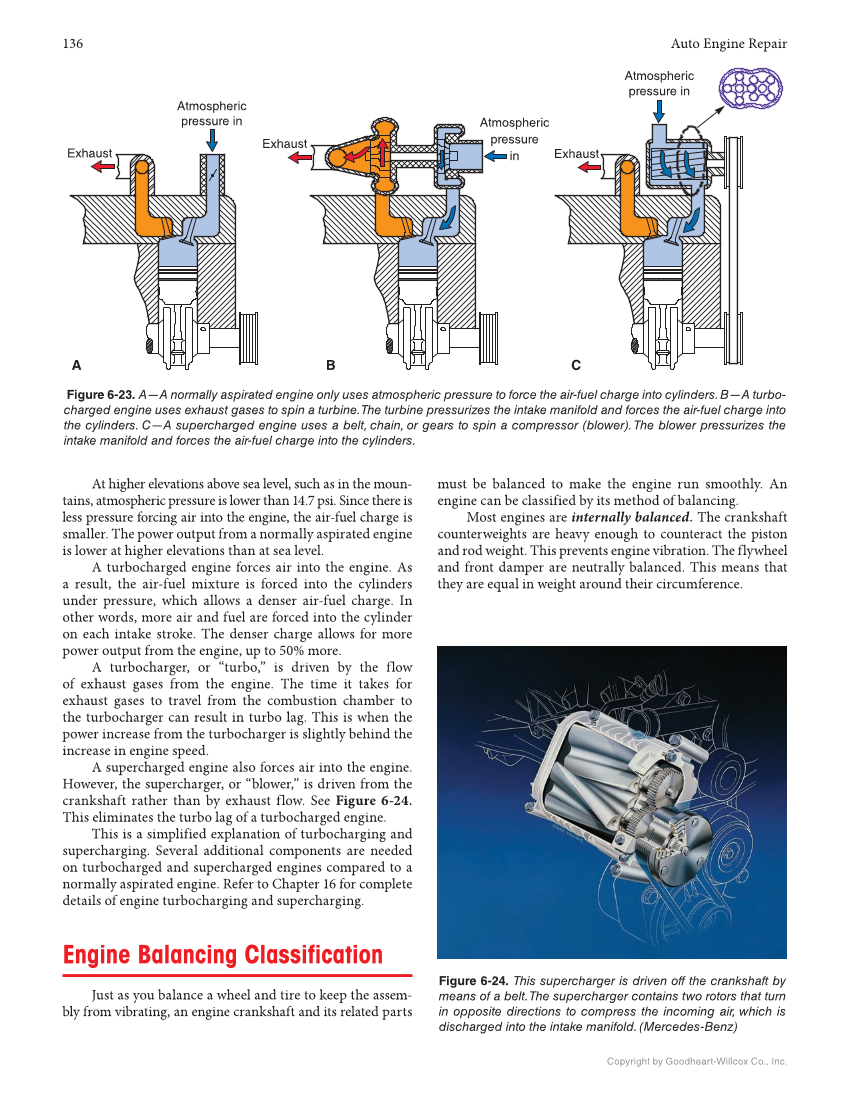136 Auto Engine Repair Copyright by Goodheart-Willcox Co., Inc. A B C Exhaust Atmospheric pressure in Exhaust Exhaust Atmospheric pressure in Atmospheric pressure in Figure 6-23. A—A normally aspirated engine only uses atmospheric pressure to force the air-fuel charge into cylinders. B—A turbo- charged engine uses exhaust gases to spin a turbine. The turbine pressurizes the intake manifold and forces the air-fuel charge into the cylinders. C—A supercharged engine uses a belt, chain, or gears to spin a compressor (blower). The blower pressurizes the intake manifold and forces the air-fuel charge into the cylinders. Figure 6-24. This supercharger is driven off the crankshaft by means of a belt. The supercharger contains two rotors that turn in opposite directions to compress the incoming air, which is discharged into the intake manifold. (Mercedes-Benz) At higher elevations above sea level, such as in the moun- tains, atmospheric pressure is lower than 14.7 psi. Since there is less pressure forcing air into the engine, the air-fuel charge is smaller. The power output from a normally aspirated engine is lower at higher elevations than at sea level. A turbocharged engine forces air into the engine. As a result, the air-fuel mixture is forced into the cylinders under pressure, which allows a denser air-fuel charge. In other words, more air and fuel are forced into the cylinder on each intake stroke. The denser charge allows for more power output from the engine, up to 50% more. A turbocharger, or “turbo,” is driven by the flow of exhaust gases from the engine. The time it takes for exhaust gases to travel from the combustion chamber to the turbocharger can result in turbo lag. This is when the power increase from the turbocharger is slightly behind the increase in engine speed. A supercharged engine also forces air into the engine. However, the supercharger, or “blower,” is driven from the crankshaft rather than by exhaust flow. See Figure 6-24. This eliminates the turbo lag of a turbocharged engine. This is a simplified explanation of turbocharging and supercharging. Several additional components are needed on turbocharged and supercharged engines compared to a normally aspirated engine. Refer to Chapter 16 for complete details of engine turbocharging and supercharging. Engine Balancing Classification Just as you balance a wheel and tire to keep the assem- bly from vibrating, an engine crankshaft and its related parts must be balanced to make the engine run smoothly. An engine can be classified by its method of balancing. Most engines are internally balanced. The crankshaft counterweights are heavy enough to counteract the piston and rod weight. This prevents engine vibration. The flywheel and front damper are neutrally balanced. This means that they are equal in weight around their circumference.
